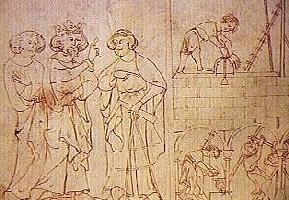Name James Saint | Role Architect | |
 | ||
Died 1309, Mostyn, United Kingdom Structures | ||
Master James of Saint George (c. 1230 – 1309), also known as Master James of Savoy and in French Maitre Jacques de Saint-Georges d'Espéranche, was an architect from Savoy, described by historian Marc Morris as "one of the greatest architects of the European Middle Ages". He was responsible for designing King Edward I's UNESCO listed castles in North Wales, including Conwy, Harlech and Caernarfon (all begun in 1283) and Beaumaris in Anglesey (begun 1295).

Archival records indicate that his father, Master John, was a master mason working on castles in the Savoy area during the mid thirteenth century - these castles included that first worked on by James of Saint George at Yverdon-les-Bains. His name "St George" is believed to be a reference to the castle of Saint-Georges-d'Espéranche, located southeast of Lyon. King Edward I probably met Master James of St George whilst returning from Crusade and visiting Savoy in 1273. It was 25 June 1273 that King Edward I of England visited Saint-Georges-d'Esperanche so that his great nephew Philip I, Count of Savoy might pay homage to him in fulfilment of an earlier 1240 agreement on Alpine tolls
Historian and Author A. J. Taylor uncovered what had been a mystery for centuries in discovering the Savoyard origins of James, that Jacques de Saint-Georges d'Esperanche and Master James of Saint George were one and the same man. Taylor travelled from Wales to Savoy noting for the first time the origins of the Welsh works in Savoy. Taylor citing the garderobes at La Bâtiaz Castle, the windows at Chillon Castle along with the town walls at Saillon as examples
The earliest references in the English records of James of St George are found in April 1278 describing him as "ad ordinandum opera castorum ibidem" that is the Mason charged with the design, technical direction and management of the works underway in Wales He is recorded as travelling to Wales, "visitandum castra de Flint et Rothelan" at which time four new castles were being built: Flint, Rhuddlan, Builth and Aberystwyth. Historian A. J. Taylor records that from 1277 until 1280 his main work was to supervise the building of Rhuddlan Castle and the canalisation of the River Clwyd before turning to Flint. Flint Castle is similar in concept to that built by Master James earlier at Yverdon-les-Bains
He was appointed Master of the Royal Works in Wales "magister operacionum in Wallia" around 1285, drawing a wage of 3s a day.
Harlech Castle, begun in 1283, was effectively completed in 1289. On 3 July 1290, James of St George was appointed Constable of Harlech Castle, succeeding John de Bonvillars who had died in August 1287. He held this position until 14 December 1293.
His final Welsh castle was Beaumaris, on which work started in April 1295. Described by historian Marc Morris as Master James "most perfectly conceived castle" it remained unfinished on his death in 1309.
James of St George had joined Edward I in Scotland, probably around September 1298. In February 1302, James of St George was appointed to oversee to the new defences at Linlithgow. He had also worked at Stirling during the siege of 1304.
There is no record of James's wife, Ambrosia, receiving a pension after his death, so it is probable she did not survive him.
